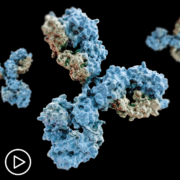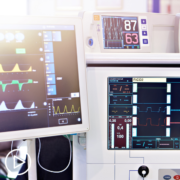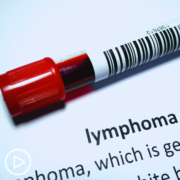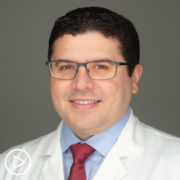Follicular Lymphoma Patient Expert Q&A: Dr. Kami Maddocks
Follicular Lymphoma Patient Expert Q&A: Dr. Kami Maddocks from Patient Empowerment Network on Vimeo.
Follicular lymphoma expert, Dr. Kami Maddocks discusses the latest in follicular lymphoma, meaningful highlights from the American Society of Hematology 2023 meeting and answers questions submitted by patients and care partners.
Dr. Maddocks is a hematologist/oncologist specializing in treating lymphatic diseases from The Ohio State University. Learn more about Dr. Maddocks.
See More from START HERE Follicular Lymphoma
Download Guide | Descargar Guía
Related Resources:

Relapsed/Refractory Follicular Lymphoma Treatments and Bispecific Antibodies |

|

|
Transcript:
Lisa Hatfield:
Welcome to the START HERE Patient Empowerment Network Program. This program bridges the expert and patient voice, enabling patients and care partners to feel comfortable asking questions of their healthcare team. Joining me today is Hematologist Oncologist, Dr. Kami Maddocks, Professor of Clinical Internal Medicine in the Division of Hematology at the Ohio State University Wexner Medical Center.
Dr. Maddocks specializes in treating patients with B-cell malignancies, including non-Hodgkin’s lymphoma, Hodgkin’s lymphoma, and chronic lymphocytic leukemia. Dr. Maddocks researches new therapies for these hematologic malignancies largely through evaluating new targeted therapies in clinical trials. Thank you so much for joining us, Dr. Maddocks.
Dr. Kami Maddocks:
It’s really a pleasure to be here with you, Lisa. Thank you so much for having me.
Lisa Hatfield:
The world is complicated, but understanding your follicular lymphoma diagnosis and treatment options along your journey doesn’t have to be. The goal of START HERE is to create actionable pathways for getting the most out of your follicular lymphoma treatment and survivorship. Joining us today are patients and care partners facing a follicular lymphoma diagnosis, some of which are newly diagnosed, in active treatment, watch and wait, and also living for years with their disease. No matter where you are in your journey, this program is designed to provide easy-to-understand, reliable, and digestible information to help you make informed decisions. I’m thrilled you’ve joined us.
Please remember before we start to download the program resource guide via the QR code. There is great information there that will be useful during this program and after. So let’s get started. Dr. Maddocks, there is a great deal going on in terms of emerging treatment options and clinical trial data in follicular lymphoma. Can you speak a bit to the exciting developments in follicular lymphoma treatment and the major highlights that are just coming out of the ASH 2023 meeting?
Dr. Kami Maddocks:
Yeah, I think it is really exciting where everything is at right now in the development of treatments for follicular lymphoma. I think one of the most exciting developments is in the immunotherapy treatments that we have. So just a year ago, we saw the approval of the first bispecific antibody in relapsed/refractory follicular lymphoma. So bispecific antibodies are immunotherapy. They target a protein on the lymphoma cell, the follicular lymphoma, but then they also target the T cell to activate it to engage the immune system to attack the lymphoma.
So these bispecific antibodies have been highly effective in relapsed/refractory follicular lymphoma. And what we saw coming out of ASH is some data looking at these in the frontline setting. So a lot of patients will get treated with immunotherapy with rituximab (Rituxan) antibody or chemoimmunotherapy with rituximab in combination with chemo therapies. And we saw some data looking at activity of these bispecific antibodies as the first-line treatment. In addition, currently right now, they’re approved as…the drug that’s approved is called mosunetuzumab-axgb (Lunsumio). That’s approved as a single agent in the relapsed/refractory setting.
And so there were some smaller trials looking at this in combination with other agents to see the outcomes that that produced. I think one of the exciting things is looking at it in combination with lenalidomide (Revlimid), which is an approved oral immunomodulatory therapy in relapsed/refractory follicular lymphoma. And then just lastly, I’ll say there were a few smaller studies looking at combinations of oral targeted therapies and immune therapies in the frontline setting as well.
Lisa Hatfield:
Great, thank you for that. And with so many of these developments, what do you think are the most important highlights for patients and families with current treatment with clinical trials? Anything that you can highlight upon for patients and families?
Dr. Kami Maddocks:
I think, really, when you look at follicular lymphoma or more recent approvals that were looking at bispecific antibodies, chimeric antigen receptor, CAR-T cells, have been approved in relapsed follicular lymphoma, EZH2 inhibitors, so targeted therapies lenalidomide. I mean, really, when you look at follicular lymphoma, we see that patients are living longer and longer. Follicular lymphoma for many patients is somewhat like a chronic disease.
It’s managed over time with periods where they get treatment and then don’t. And what you look at with all of our therapies is we really are looking at immunotherapy and targeted therapies, both in the relapsed setting, but also now in the frontline setting, as opposed to or in place of chemotherapy.
Lisa Hatfield:
Great. Thank you. So you probably have a number of patients who are in the watch-and-wait mode right now. When do you decide when you use these particular therapies? And if you use them earlier on, is there any chance of managing the follicular lymphoma longer or a longer remission?
Dr. Kami Maddocks:
That’s a great question. So from what we know from follicular lymphoma, it’s, as I mentioned, an indolent lymphoma, not curable, but very treatable. So many patients that are diagnosed with follicular lymphoma, the median overall survival is very long, and it’s more, again, like a chronic disease that we manage with treatment. So sometimes we recommend watch-and-wait because patients, there’s never been any study showing that early treatment with the therapies we had improved overall survival. So it’s a balance between deciding when patients have a need for treatment versus not exposing them to treatment that can cause toxicities, if we know that it ultimately doesn’t make them live longer.
But, of course, we want to both treat patients who need disease treatment either for symptoms or for things that are going on by the size of their lymph nodes. So when patients have low blood counts, when they have symptomatic lymph nodes, when they have lymph nodes that are potentially causing a problem to an organ, or we foresee that it could cause a problem to an organ, when they have certain burdens of disease or when they have enough and large lymph nodes that we think that there’s going to be a problem in the near future without treating is when we decide to initiate that treatment.
Lisa Hatfield:
So when you do have patients going through therapy, what are the typical side effects? And how do you help them manage those side effects of treatment?
Dr. Kami Maddocks:
Yeah, that’s a great question, and it’s very dependent, because we have so many different treatments now. It’s very dependent on the treatments that the patient’s getting. So things like single-agent antibody therapy with single-agent rituximab, most of the time, the biggest risk of that is the first time a patient can get it, they can have an infusion reaction. That’s managed as it’s happening. And then they tolerate that, in general, fairly well. That does wipe out the lymphocytes, as most of the treatments do, and puts patients at increased risk of infections, particularly viral infections for a period of time.
Chemotherapy, the most common chemo that we give for follicular lymphoma, I would say nausea, fatigue, and an increased risk of infection are kind of the bigger things. Bendamustine (Treanda) is a commonly used chemotherapy for follicular lymphoma, and that’s some of the big side effects from that.
Lenalidomide, the oral pill, so cytopenias infection, GI toxicity and rash are potentially the more common side effects of that. Less common, but we’re always concerned about blood clots, so most patients will take either an aspirin or a blood thinner, depending on their clot history when they’re on lenalidomide. The bispecific antibodies have a particular risk called cytokine release syndrome, so that immune systems activated, but it can almost get overactivated.
The most common symptom of that is fever, and so patients are counseled very closely on that. But activation of the immune system with that fever can also include changes in blood pressure or the need for some oxygen. Some of the CAR T-cell therapy has the same risk of the cytokine release, also has potential neuro side effects. And then longer term is just how long the patients’ immune systems take to recover. There can be risk for infections.
Lisa Hatfield:
Okay, thank you for that information, that overview. That’s great information for patients to have. So regarding clinical trials right now, are there any clinical trials that you are conducting or that you’re particularly excited about for patients that they might want to ask their providers about?
Dr. Kami Maddocks:
Yes, so we’re also looking at opening a trial for frontline follicular lymphoma that looks at the use of bispecific antibodies. So I think that’s very exciting, because in general, it’s a well-tolerated therapy. And I think if it gives us a chance to produce very good outcomes, but without the toxicity of chemotherapy in the frontline setting, that to me is super exciting for patients. We’re also looking at different bispecific antibodies. So they currently approved one target CD20. We have a CD19-targeted bispecific antibody that I also think is exciting to look at the potential for different targets because then once a patient has had one, you’re targeting something different, and the thought is that they might still be able to respond to a different one.
Lisa Hatfield: Yeah. So with bispecifics then, is that continuous therapy, or is that limited duration therapy?
Dr. Kami Maddocks:
It actually depends on the bispecific. So in follicular right now, the one approved is for a limited duration. When you look at a few of the others that have been approved and other lymphomas that are being studied in follicular lymphoma, there’s a little bit of a variation between continued treatment and limited-duration therapy. I think what’s exciting about a lot of the combination studies is they are more looking at a defined period of time with the combinations.
Lisa Hatfield: Which I’m sure a lot of patients love to hear that. Limited duration, there’s an end to this possibly, so yeah.
Dr. Kami Maddocks:
Yeah. Nobody wants to be on treatment forever.
Lisa Hatfield:
That is true. Yeah. Well, thank you so much for that important overview, Dr. Maddocks. It’s that time where we answer questions that we’ve received from you in the audience. Remember, as patients, we should always feel empowered to ask our healthcare providers any and all questions we might have about our treatment and prognosis. Please remember, this program is not a substitute for medical care. Always consult with your own medical team.
So we have a patient who is asking, “What is the recommended frequency and length of imaging PET-CT as a diagnostic tool?” And I wonder if it might be helpful, since we have a broad range of…our audience kind of runs the gamut of newly diagnosed to people who are in remission, people in watch and wait, maybe you can explain the frequency and length of imaging for those who are watching and waiting, and also for those who are maybe in remission, and those who are currently in active treatment.
Dr. Kami Maddocks:
Yeah, so I think this is a great question. I think the important thing about PET scans is to recognize where and when they have a role in follicular lymphoma, because they’re not used as monitoring tools in follicular lymphoma long term in either watch and wait, typically, or in patients who’ve had treatment. So follicular lymphoma, when patients have a diagnosis, we like to get a PET scan, because it helps us stage the follicular lymphoma a little bit better than just generalized CT scans. When patients are being monitored and they have a change in symptoms, a change on maybe routine CT scans and their physical exam in their labs, then you may want a PET scan. We always want to get one before a patient requires treatment, and then after a patient has treatment to help determine the response by PET scan.
As far as monitoring in patients who are on watch and wait or monitoring in a patient who’s received treatment, routine PET imaging is actually not recommended. It’s not recommended by the guidelines. And honestly, they’re not usually approved by insurance for routine monitoring, because they’re not recommended. So what is recommended is seeing your physician, usually at a three to six-month window, depending on where you are in your journey. And then usually, for routine monitoring, CT scans are done. If somebody’s in watch and wait, oftentimes they might initially be done at three months, then six months, then even yearly, and same with after treatment.
Lisa Hatfield:
All right, thank you. So another person is asking, “How long does it take for the immune system to really start bouncing back after follicular lymphoma treatment? And what blood test results indicate a weakening immune system?”
Dr. Kami Maddocks:
Yeah, so this is a great question. [chuckle] It also can be a complicated question with many different answers. So one, it can depend on the treatment that a patient receives. Two, it can actually depend on their different parts to the immune system. So different parts of the immune system can recover at different time periods from treatment. So acutely, our neutrophils are something that often gets…they’re bacteria infection fighting cells. Those are the cells that during chemotherapy, when that count gets low and patients are counseled on if you have a fever during your treatment, you need to be evaluated and be seen because if you have an infection and a fever during chemo or some of these treatments, your blood counts are low, you might need to be in the hospital on IV antibiotics.
So those neutrophil part of it are usually quicker to recover, so they drop with treatment and then recover pretty quickly with each cycle, including after an ended treatment cycle. Sometimes when patients have been treated with several different therapies, it can be harder for those cells to recover. They can stay lower for longer. Then there’s a component of the immune system, so we are ripping out the lymphocytes, because that’s what the cancers have.
And so things targeted. Chemotherapy in general kills the lymphocytes but there also are targeted therapies like rituximab bispecific antibodies CAR T-cells those are particularly wiping…targeted towards proteins on the lymphocytes and wiping them out. Those can be for a more prolonged time. In general, we usually think of about a six-month period so patients can be at increased risk for viral infections in that six-month period may not respond as well to vaccines in that period.
But for some patients it takes longer and some patients recover quicker. It also can depend on where patients are at in their journey because every therapy that they’ve had can take a little bit longer to recover. The last part I’ll add is just sometimes when the lymphocytes are wiped out for a long time people’s proteins, their immunoglobulins that help fight infection get low. And so sometimes we actually will end up giving patients replacement of IVIG to help if they’re having lots of infections.
Lisa Hatfield:
All right. Thank you. Another good question, and this comes up with many blood cancers or a lot of cancers. Should patients be mindful of beauty products such as shampoos, soaps, and sunblocks when in remission for follicular lymphoma?
Dr. Kami Maddocks:
That’s another great question. I am not aware of any data connecting those specific things.I think patients definitely should be wearing sunblock, because we know that a lot of patients with blood cancers can get secondary malignancies. So being careful of being…we also know, I should say, even patients who are getting treated can have a more sensitivity to the sun. So being careful with sun precautions, either avoiding the sun or wearing sunblock, making sure you’re covered when you go outside. I’ll even say I’ve seen a few patients who during treatment have gotten bad windburns. So your skin definitely can be more sensitive when you’re receiving therapies.
Lisa Hatfield:
All right, thank you. Let’s see here. This patient is asking if you are in remission for a long period of time after follicular lymphoma treatment, can you technically be cured in some cases, or are you considered to still have the cancer?
Dr. Kami Maddocks:
So that is a great question. There’s a term that’s used in follicular lymphoma called a functional cure. So we have patients that essentially get treated, and they live long enough that they die from something else without their follicular lymphoma ever relapsing. So while we say from what we know if somebody lives long enough that this disease is likely going to relapse at some point, there are patients that will be treated, and the disease will never come back.
Lisa Hatfield:
Okay. That’s helpful, thank you. Can patients facing follicular lymphoma be considered immunocompromised if they’re in remission?
Dr. Kami Maddocks:
I think this kind of goes back to when we talked about the immune system recovery that this can be a little bit of a complicated question, because it depends a little bit on the treatment that they got, how far out from the treatment they are and how many treatments they’ve had in the past. So, in general, if I have a patient that has received therapy, their counts have recovered, they in general look like…their lab work looks like their immune system, then in general I would say that they have an immune system that’s likely similar to somebody who didn’t have the follicular lymphoma, and they’re going to be able to fight infections and respond to vaccines.
I think what we do know is sometimes when patients get rituximab maintenance or obinutuzumab (Gazyva) maintenance or some of the chemotherapies there are some patients that can have a longer time that they’re immunosuppressed. So I think this is always something that’s good to ask your doctor for. In your specific situation with the treatment you received, when do you expect to have a regularly functioning immune system?
Lisa Hatfield:
For follicular lymphoma, what are the predictors of transformation and relapse, and what symptoms should patients be looking out for and tell their doctor about?
Dr. Kami Maddocks:
Yeah, so I think this is a great question. As far as just in everybody predicting when they’re going to progress, when they’re going to relapse, we don’t actually have great ways to do that right now. One of the things that has been shown to potentially predict things is for patients who do receive treatment if they have an early relapse, that suggests that their disease is going to behave more aggressively. As far as looking for relapse, things that people want to look for, not all patients will have symptoms but certainly if patients feel any lumps or bumps if they start…I like to tell my patients if you…patients usually know if something’s wrong.
So everybody’s going to have aches and pains, everybody’s going to have the normal infections, but if you’re not feeling well significant fatigue night sweats fevers are always something that we look for but that’s not something that everybody has. New pains, not feeling well, just kind of the inability to feel like you can keep up with what you’re doing daily, those are always things that you should at least call in to see if you should be evaluated. It’s important to know that follicular lymphoma patients are followed. As I said, you are followed forever. We do also watch your blood counts to make sure that we’re not seeing changes in blood counts, changes in lactate dehydrogenase which is a non-specific marker but something that we follow in lymphoma.
Lisa Hatfield:
Okay. Thank you. And one follow-up to that question also. So are there follicular lymphoma specialists? If a patient is maybe in an area that doesn’t have a large academic center or a large cancer institution, do you recommend they see somebody who specializes in follicular lymphoma or can they see even for a consult or do you think that their local hematologist oncologist is very familiar with that themselves? Do you have recommendations?
Dr. Kami Maddocks:
Yeah, so that’s a great question. Local, I think follicular lymphoma is common enough that a lot of our general oncologists who see everything see follicular lymphoma. I think it never hurts of course to ask about clinical trials. So if that’s something that might be available. If it’s available, it might be worth going to a specialist for. If there’s concerns, I think it’s always a good idea to get a second opinion to make sure that a patient is comfortable.
I think if a patient seems to have a more aggressive behaving follicular or if they’ve had a lot of different treatments, that’s also if you’re seeing a general oncologist at a time, that it’s good to see if there are clinical trials or if a specialist has anything new or different.
Lisa Hatfield:
Okay. Thanks. So we have a person asking, “Does lymphoma recurrence always happen in an aggressive manner?”
Dr. Kami Maddocks:
That’s a great question. The answer is no on that, and in fact lymphoma recurrence doesn’t always need to be treated just because it does recur. So when you look at follicular lymphoma, there are patients who are in a watch-and-wait period. When they’re diagnosed, they’ll eventually progress to requiring treatment or most…well, there are patients who might not. Once they require treatment, they get a time period without…most of them will get a time period without disease.
There are patients who will…that you’ll find lymph nodes growing on CT scans maybe that you’re doing monitoring for, but the patient will otherwise feel well. They won’t have, necessarily, very big lymph nodes. Their blood counts will be okay and you may say, okay, just like you had watch-and-wait to start with, we’re going to watch and wait right now with this relapse, because you don’t have any indications that are saying we need to treat this.
And again that doesn’t necessarily make our patient live longer. So you want to balance their quality of life and toxicities of treatment. There are patients who will…when they relapse, they will have indications for treatments, and then there are patients who will potentially have more aggressive relapses and be very symptomatic or have larger lymph nodes.
Lisa Hatfield:
Okay. All right. So one person says, “I’m currently in remission, what can I expect in my future? How long does remission last? And is treatment after remission the same as initial treatment?”
Dr. Kami Maddocks:
So that is very dependent on what a patient receives. So there are different kind…of a lot of our treatments we look at median times. When patients have relapse, that can be a little bit different for single agent antibody therapy versus antibody in combination with chemoimmunotherapy for how long that treatment remission lasts.
As far as we don’t typically reuse a treatment once we have used it before, although there is data in follicular lymphoma when patients receive single agent antibody. So rituximab alone, if they do well with that single agent immunotherapy for a long period, they may receive re-treatment with just that so long as they don’t have disease that requires more aggressive treatment.
Lisa Hatfield:
Okay. So is that more likely to happen then if a patient maybe wasn’t refractory to it, if they just stopped using it for some reason? Would that be more common for that to happen to go back on that same drug?
Dr. Kami Maddocks:
So with rituximab, we use it alone and in combination. So there are some patients that don’t necessarily have what we call a large tumor, and they don’t have a lot of lymph nodes or they don’t have large lymph nodes but they might be symptomatic from them or the location might be problematic. And so once these lymph nodes get a certain size, they usually don’t have as good of a response to single agent antibody therapy. But there are patients who have small lymph nodes that aren’t as big but again are causing a problem that can get completely…you give a short course of the rituximab, and it can last for a very long time and then you would consider again using a short course of that rituximab.
The chemotherapies we have, we don’t reuse chemotherapy, for the most part. Some of that, for a while, there was bendamustine if patients got five, six, 10-year remissions out of it. Sometimes they would re-get that chemotherapy. But I think we’ve just seen so many newer therapies approved in the last five six years. Like the bispecifics, the EZH2 inhibitors, lenalidomide, CAR T, we had different PI3K inhibitors available for a while. And so I think it was just that you had the ability to offer a patient something that they never had before, and that is more appealing.
Lisa Hatfield:
Okay. Thank you. So you spoke a little bit about IVIG infusions before and this person is saying that, “I’m having to do IVIG infusions, which started years after my treatment due to my IgG numbers being low. Are nausea and headache side effects common?”
Dr. Kami Maddocks:
Yeah, so some patients can have nausea, headache, myalgia, body aches, some get fevers and some infusion reactions. For some patients, they can have that from the start, some patients can develop it. That’s always a good thing to talk to your doctor about. There are different products for IVIG, and sometimes patients are able to switch products. I will say IVIG can be very insurance-dependent, so it’s also sometimes what…the formulation that insurance…an individual’s insurance covers. But yes, these are side effects, they’re worth, if they’re getting worse or lasting a long time, making sure that it’s discussed with the physician prescribing it.
Lisa Hatfield:
Okay. All right. One person is saying, “I’m in watch and wait currently. Is it possible that I’ll never need treatment or how long do you wait and what am I waiting for?”
Dr. Kami Maddocks:
That is a great question. There are patients in watch and wait who will never require treatment. Watching and waiting, we’re watching blood counts, watching the size of lymph nodes. So things that we’re watching for and you’re watching for are changes in lymph nodes size, so are they growing? Are they becoming more symptomatic? Is there a rapid change in them? Are we seeing a change in the blood counts? Are patients starting to have a drop in their blood counts which can happen if somebody’s spleen is getting bigger if they have lymphoma in their bone marrow and that’s progressing, watching for if the lymph nodes are causing a problem, you notice somebody have one in a location like the neck that’s starting to make swallowing difficult or changes in voice, that’s something you want to treat. And then there’s something called B symptoms that we watch for. So if the patient had night sweats…
…night sweats are like drenching night sweats, soak the bed, have to change clothes potentially sheets, fevers, so daily fevers that occur, or significant or rapid weight loss for no reason. All those are kinds of things that we want people to watch for. And we discussed a little bit too if patients start having extreme fatigue, not feeling well, not being able to eat, not having appetites if they have a new pain. And again everybody can have aches and pains. But if you’re having pain that’s not going away or some sort of symptom that’s not improving, those are all things we want to definitely have checked out.
Lisa Hatfield:
Okay. Thank you. I imagine with some of your patients in that mode, there’s what I call the mental gymnastics of thinking, okay, I have this cancer, but I can’t do anything about it, and these symptoms are really vague that come up. So do you allow your patients just to contact you if they’re saying, “I think I have these symptoms, I’m nervous about this.” Can they come in and have a visit with you or contact you at any time?
Dr. Kami Maddocks:
Oh, yes. So we have a 24-hour triage line. I recommend that if patients have a question or concern, it’s better to ask us because if we don’t know about it, we can’t help is the first thing. Usually, we talk to the patient and say, okay, how long has this been going on and see if it’s a red flag like you need to come in right now or is this something that maybe we might recommend getting a set of labs to look at certain labs to see if they’ve changed at all. We might say okay this seems like something we should actually see you for, but I want CT scans too so let’s order them so I can have that information when you see me.
So, yeah, I think people should always call with any signs, symptoms, concerns, and then it can be addressed. Now, there are some things that we might say, okay, we think based on everything that new cough is probably more likely a respiratory infection. It’s okay to see your PCP, but we also go through that as well. So yes, I think it’s always best to check in and not let something go.
Lisa Hatfield:
Okay. Thank you. I’m guessing that’s challenging for some of those people in that mode, just thinking, well, I’m just waiting here, so that’s got to be a little bit more challenging.
Dr. Kami Maddocks:
I think you’re absolutely right. And sometimes there’s a benefit to…certainly like rituximab therapy when there is a disease there, and it is a challenge to think that it’s not being treated.
Lisa Hatfield:
Okay. Thank you. This is I guess the last or second to the last question we have. Dr. Maddocks, can you speak to maintenance therapy and monitoring and follicular lymphoma, and what signs of infection should patients and care partners be aware of during treatment?
Dr. Kami Maddocks:
Yeah, so maintenance therapy, in follicular lymphoma is something, so maintenance antibody therapy after initial chemo…usually, chemoimmunotherapy is something that’s been studied that’s shown in some patients to provide a benefit as far as keeping disease away longer and a remission longer. But then it’s also been shown to be associated with a higher risk of infection, because you’re keeping those lymphocytes wiped out, particularly when it’s given as maintenance after certain chemotherapies in addition to the immunotherapy. So it can be a balance. I think maintenance isn’t something that every follicular lymphoma patient gets, but it’s something also that is used.
So that’s the first thing in discussion with your doctor, is this something that maintenance is recommended? Why or why not? Then watching during maintenance usually if people start to have more infections, which are oftentimes sinus respiratory infections, then we’re thinking about, okay, is this somebody that has low immunoglobulins? Do we need to check those? Are we worried about them? Needing to stop maintenance, potentially needing IVIG.
Lisa Hatfield:
Okay. Thank you. And then this is a Lisa question, “Do you know if there’s any data to suggest that the follicular lymphoma or any type of non-Hodgkin’s lymphoma has a familial or hereditary component?”
Dr. Kami Maddocks:
So there are very small number of…in non-Hodgkin’s lymphoma, there are some small familial components. Unlike, however, say breast cancer where there’s specific genes to test for, we don’t have that as a screening here in non-Hodgkin’s lymphoma.
Lisa Hatfield:
Dr. Maddocks, thank you so much for being part of this Patient Empowerment Network START HERE program. It’s these conversations that help patients truly empower themselves along their treatment journey. And on behalf of patients like myself and those watching, thank you very much, Dr. Maddocks.
Dr. Kami Maddocks:
Lisa, thank you so much for having me. It’s been a great conversation and hopefully it can help some people.
Lisa Hatfield:
I hope so too. I’m Lisa Hatfield. Thank you for joining this Patient Empowerment Network program.
Share Your Feedback:
Create your own user feedback survey




















